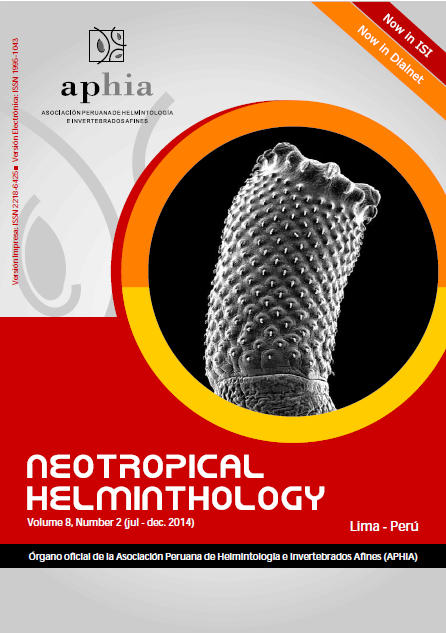CYSTACANTHS OF GIGANTORHYNCHUS ECHINODISCUS (ACANTHOCEPHALA, GIGANTORHYNCHIDAE), IN NEOTROPICAL TERMITES (ISOPTERA, TERMITIDAE)
DOI:
https://doi.org/10.24039/rnh201482925Keywords:
Anteaters, Cornitermes, Gigantorhynchus lutzi, intermediate hosts, life cycles, Labiotermes, morphology alteration, Orthognathotermes.Abstract
Specimens of Labiotermes emersoni (Araujo, 1954) and Orthognathotermes heberi Raw & Egler, 1985, were collected at Parque Nacional da Serra da Canastra, State of Minas Gerais, Brazil. Soldiers of the two species were suspected to carry larval acanthocephalan parasites due to different sizes and shape of their heads and because some specimens had a conspicuous, cylindrical, whitish 'body' in the hemocoel, around the digestive tract in the abdomen. The termites showed shape alteration and light pigmentation dystrophy of the heads induced by the larval acanthocephalans. These alterations were documented photographically and the cystacanths described. The encysted juveniles removed from the hemocoel of infected soldier termites and processed accordingly, were determined as Gigantorhynchus echinodiscus (Diesing, 1851). The proboscis had the typical cylindrical shape and the characteristic two distal circles of large hooks (6+12), covered with small, almost rootless spines, and a very short neck. This is the first record from Brazil of any species of termites infected with acanthocephalans of the genus Gigantorhynchus Hamann, 1892 and the first record of G. echinodiscus cystacanths infecting the intermediate host.
Downloads
Published
How to Cite
Issue
Section
License
Copyright (c) 2021 Neotropical Helminthology

This work is licensed under a Creative Commons Attribution-NonCommercial-NoDerivatives 4.0 International License.
OBJETO: El AUTOR-CEDENTE transfiere de manera TOTAL Y SIN LIMITACIÓN alguna al CESIONARIO los derechos patrimoniales que le corresponden sobre la (s) obra(s) tituladas: xxxxxxxxxxxxxxxx, por el tiempo que establezca la ley internacional. En virtud de lo anterior, se entiende que el CESIONARIO adquiere el derecho de reproducción en todas sus modalidades, incluso para inclusión audiovisual; el derecho de transformación o adaptación, comunicación pública, traducción, distribución y, en general, cualquier tipo de explotación que de las obras se pueda realizar por cualquier medio conocido o por conocer en el territorio nacional o internacional.
REMUNERACIÓN: La cesión de los derechos patrimoniales de autor que mediante este contrato se hace será a título gratuito.
CONDICIONES Y LEGITIMIDAD DE LOS DERECHOS: El AUTOR-CEDENTE garantiza que es propietario integral de los derechos de explotación de la(s) obra(s) y en consecuencia garantiza que puede contratar y transferir los derechos aquí cedidos sin ningún tipo de limitación por no tener ningún tipo de gravamen, limitación o disposición. En todo caso, responderá por cualquier reclamo que en materia de derecho de autor se pueda presentar, exonerando de cualquier responsabilidad al CESIONARIO.
LICENCIA DE ACCESO ABIERTO: El AUTOR-CEDENTE autoriza que manuscrito publicado en La Revista Neotropical Helminthology permanece disponible para su consulta pública en el sitio web https://www.neotropicalhelminthology.com/ y en los diferentes sistemas de indexación y bases de datos en las que la revista tiene visibilidad, bajo la licencia Creative Commons, en la modalidad Reconocimiento-No comercial- Sin Trabajos derivados –aprobada en Perú, y por lo tanto son de acceso abierto. De ahí que los autores dan, sin derecho a retribución económica, a la Asociación Peruana de Helmintología e Invertebrados Afines (APHIA), los derechos de autor para la edición y reproducción a través de diferentes medios de difusión.


 Numero 2 Volumen 19 - 2025 (versión Anticipada)
Numero 2 Volumen 19 - 2025 (versión Anticipada)














































